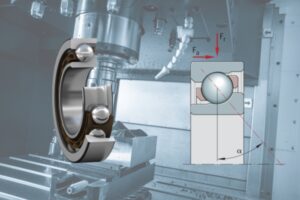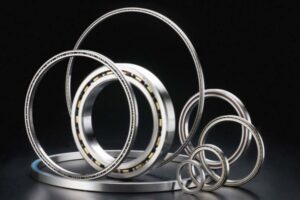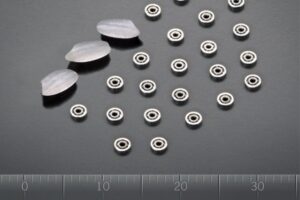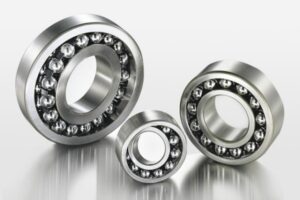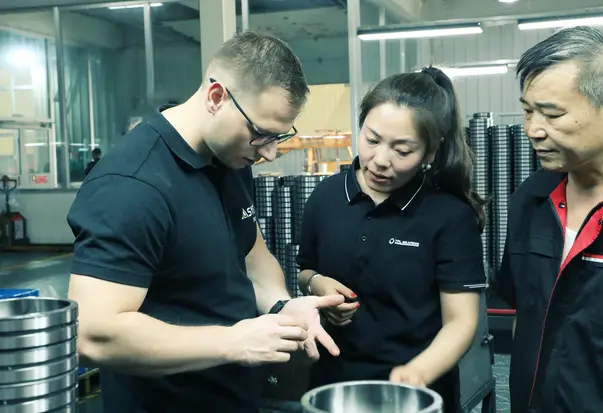3D printing bearings have changed how engineers design and produce precision components. Manufacturers now enjoy greater freedom to create custom shapes and rapidly test new ideas. In many cases, additive manufacturing methods like powder bed fusion or fused deposition modeling offer lower costs for small production runs.
For example, a bearing block produced with powder bed fusion costs less than CNC milling when making fewer than 5,000 units.
| Manufacturing Method | Part Type | Break-even Volume (units) |
|---|---|---|
| Powder Bed Fusion vs CNC | Bearing block | < 5,000 |
This shift raises an important question: how did 3D printing bearings move from early experiments to real industrial use?

Key Takeaways
- 3D printing allows fast, cost-effective production of custom ball bearings, especially for small batches and prototypes.
- Materials like polymers, ceramics, and metals each offer unique strengths and suit different bearing needs and industries.
- 3D printed bearings provide design freedom, enabling complex shapes and quick adjustments that traditional methods cannot easily achieve.
- Industries such as aerospace, automotive, and medical use 3D printed bearings for lightweight, specialized, and maintenance-free parts.
- While 3D printed bearings have some strength and durability limits, ongoing innovation and testing improve their performance and expand applications.
3D Printing Ball Bearings Experimentation
Hobbyist Models
Makers and hobbyists have played a key role in the early development of 3D printing bearings. They often start with simple models, such as single-row ball bearings or fidget spinner bearings. These models allow users to test the limits of their printers and materials. Many hobbyists share their designs on online platforms, making it easy for others to download and print their own bearings. This open sharing helps the community learn and improve quickly.
Print-in-Place Designs
Print-in-place designs have become a popular choice for 3D printing bearings. These designs allow users to print moving parts in one step, without assembly. For example, a footwear company used Inkbit’s Vision-Controlled Jetting technology to create flexible shoe components with high accuracy. This method removed the need for expensive molds and cut prototyping time from months to about a week. Design for Additive Manufacturing (DfAM) strategies, such as lightweight structures and hollow parts, help reduce material use and build time. Batch ordering and flexible deadlines also make production more efficient and less costly.
Print-in-place bearings show how 3D printing bearings can save time and money while offering new design possibilities.
Customization
Customization stands out as a major advantage in 3D printing bearings. Users can adjust the size, shape, and material of their bearings to fit specific needs. Many online files come with parameters that let users change dimensions before printing. Community sharing encourages people to post their custom designs and improvements. This culture of sharing and customization helps drive innovation and makes it easier for anyone to create a bearing that fits their project.
Materials and Design
Ceramic Bearings
Ceramic materials have gained attention in the field of 3D printed bearings. Researchers have tested ceramic–polymer composites, including pottery clay-type, terracotta-type, concrete-type, and granite-type. These studies show that the infill density of the printed part has the strongest effect on how much force the bearing can handle. The terracotta-type composite stands out for its high mechanical resistance, while the concrete-type shows the lowest. Scientists use mathematical models and computer simulations to understand how cracks start under pressure. These findings support the use of ceramic composites for bearings or linear guides, especially in situations with low mechanical stress. Ongoing research also explores how to improve the physical and mechanical properties of these materials, opening new possibilities for medical and antibacterial applications.
Polymer and Composite Bearings
Polymers such as ABS, PLA, and nylon are common choices for 3D printed bearings. Each material offers different strengths. For example, ABS provides the highest wear resistance, making it suitable for parts that need to last longer. Nylon, on the other hand, has the lowest wear resistance among the tested polymers. Researchers focus on optimizing the surface texture, rotor speed, and load to improve performance. While direct comparisons to metal bearings are limited, these polymer bearings work well in applications where weight and cost matter more than extreme strength.
Tip: Choosing the right polymer can help balance durability and production cost for custom bearing solutions.
Metal Bearings
Metal 3D printing brings new opportunities for high-performance bearings. Technologies like selective laser melting and electron beam melting allow engineers to create complex shapes with strong metals such as stainless steel and titanium. These metal bearings can handle higher loads and temperatures than their polymer or ceramic counterparts. Industries like aerospace and automotive use metal 3D printed bearings for prototypes and specialized parts. The ability to produce small batches quickly helps companies test new designs without waiting for traditional manufacturing.
3D Printing Ball Bearings in Industry
Prototyping and DIY
Many companies and individuals use 3D printing ball bearings for prototyping and DIY projects. These bearings help engineers and designers test new ideas quickly. For example, igus® produces 3D printed bearings from high-performance polymers. Their products show wear resistance up to 50 times greater than standard 3D printing materials. These bearings run smoothly without oil or grease, making them maintenance-free and dirt resistant.
- Custom shapes and sizes can be made in as little as 72 hours.
- No minimum order quantity allows for small batch production and rapid prototyping.
- These bearings work well in robotics, automotive, aerospace, industrial machinery, and medical devices.
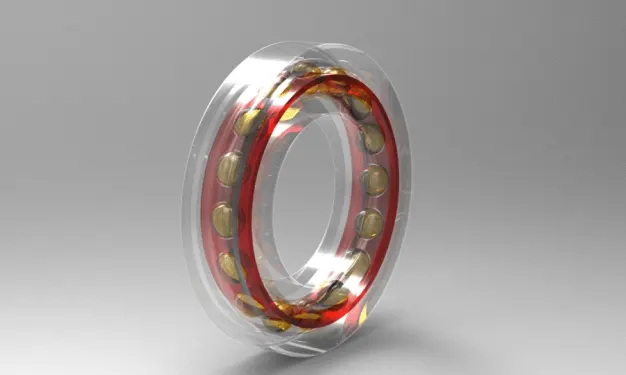
Polymer 3D printing acts as a helpful tool alongside traditional manufacturing. It enables fast prototyping and can sometimes match the performance of metal parts. However, strict testing and standards remain important, especially for safety-critical uses. This approach shows that 3D printing bearings have become more reliable and useful across many industries.
Industrial Applications
Industries now use 3D printing ball bearings for more than just prototypes. Aerospace companies print custom bearings for lightweight aircraft parts. Automotive engineers design special bearings for electric vehicles and racing cars. Medical device makers use 3D printing to create patient-specific implants and surgical tools.
Many factories choose 3D printing bearings for small production runs or unique designs that traditional methods cannot make easily.
The ability to print complex shapes and use advanced materials helps companies solve tough engineering problems. For example, self-lubricating bearings reduce the need for maintenance in machines that run in dirty or hard-to-reach places. The flexibility of 3D printing also allows for quick changes in design, which speeds up product development.
Performance
Performance remains a key factor for 3D printing ball bearings in industry. Engineers measure load capacity and lifespan using strict tests. For example, researchers have tested polymer hybrid ball bearings made by additive manufacturing. These bearings lasted about 8 hours under a 1 kg load at 1000 rpm. Experts use vibration analysis and sensors to track wear and predict when a bearing will fail.
- Some bearings meet annual rebuild needs, while others last 5 to 10 years, depending on the application.
- Companies use these tests to make sure their bearings meet service life expectations.
Cost-effectiveness also matters. 3D printing bearings often cost less for small batches or custom parts. They save time and money by reducing the need for molds and tooling. As a result, more industries trust 3D printing bearings for both prototypes and real-world use.
Advantages and Limitations
Design Freedom
3D printing gives engineers the power to design ball bearings with shapes and features that traditional methods cannot achieve. They can create custom parts for unique machines or special projects.
- Dimensional accuracy in 3D printed parts often stays within 2 mm of the original design, showing high precision.
- Mechanical stiffness in nylon parts made with selective laser sintering matches targeted values within 5%.
- Bending stiffness in polycarbonate parts printed by fused deposition modeling shows an average error of only 0.20 Nm/deg.
These results prove that 3D printing can deliver complex, customized bearings with reliable mechanical properties. This design freedom helps companies solve problems and meet special requirements faster than before.
Note: Customization allows for quick changes in design, making it easier to adapt to new challenges or customer needs.
Rapid Production
Speed is a major advantage of 3D printing bearings. Engineers can move from a digital design to a finished part in just a few days. This rapid production helps companies test ideas quickly and bring new products to market faster.
- Additive manufacturing methods like powder bed fusion and vat photopolymerization offer high accuracy and fast turnaround.
- Material extrusion and direct energy deposition allow for scalable production and quick prototyping.
Many industries use 3D printing to make small batches or one-of-a-kind parts without waiting for molds or special tools. This flexibility supports innovation and reduces time spent on development.
Economic Factors
Cost savings play a big role in the adoption of 3D printing bearings. Studies show that additive manufacturing can lower unit production costs, especially for small runs or complex assemblies.
- A ball bearing assembly that once needed 18 separate parts can now be printed as a single piece, saving time and money.
- Economic models highlight that government subsidies and supply chain coordination can make 3D printing even more cost-effective.
- Surveys and industry reports point to growing investment in 3D printing due to these savings.
| Manufacturing Method | Complexity | Cost for Small Batch | Assembly Required |
|---|---|---|---|
| Traditional | Low | High | Yes |
| 3D Printing | High | Low | No |
Tip: Companies can reduce waste and avoid extra costs by printing only what they need, when they need it.
Material and Performance Limits
Despite many benefits, 3D printing bearings face some important limits. Material choices and load capacity often fall short of traditional metal bearings.
- Tests on ABS and PLA cylinders show that actual buckling loads are only about 53% to 62% of theoretical values.
- ABS cylinders handle about 3 kN, while PLA cylinders manage around 1 kN, both lower than expected.
- Thermoplastics can show brittleness and viscoelastic behavior, which affects how long a bearing will last under stress.
- Printing limitations, such as minimum wall thickness and print defects, can reduce strength and reliability.
Different 3D printing methods also have their own drawbacks:
- Powder bed fusion offers high accuracy but needs expensive equipment and post-processing.
- Vat photopolymerization gives fast results but produces brittle parts and uses hazardous resins.
- Material extrusion is affordable but often results in rough surfaces and weaker parts.
The bearing industry uses strict tests to measure friction, wear, and corrosion resistance. Lubrication remains a challenge, with 13% of bearing failures linked to poor lubrication. Computer simulations help predict performance, but real-world limits still exist.
Engineers must balance the benefits of speed and customization with the need for strong, reliable materials. Not every application will suit 3D printing bearings, especially where high loads or long service life are required.
3D Printing Ball Bearings: Trends and Outlook
Market Growth
The market for 3D printing bearings continues to expand. In 2024, the polymer ball bearings market reached a value of $3.5 billion. Experts predict this figure will grow to $5.2 billion by 2033, with a compound annual growth rate of 4.8%. This steady rise shows strong demand across many industries. Companies invest in new technologies and materials to meet changing needs. The growth also reflects a shift toward lighter, more efficient components in vehicles, aircraft, and machines.
Adoption Drivers
Several factors drive the adoption of 3D printing bearings. Lightweight and corrosion-resistant bearings now appear in electric vehicles and aircraft. Medical device makers use lubrication-free, sterilizable bearings in imaging equipment. Robotics and automated factories rely on high-performance, low-maintenance bearings. Environmental rules in Europe and North America encourage the use of non-metallic bearings to reduce heavy metal use. The table below highlights key drivers:
| Driver Category | Insight |
|---|---|
| Automotive & Aerospace | Lightweight, corrosion-resistant bearings for EVs and aircraft |
| Medical Devices | Lubrication-free, sterilizable bearings in diagnostic equipment |
| Industrial Automation | High-performance bearings for robotics and manufacturing |
| Environmental Regulations | Favor non-metallic bearings to reduce heavy metal usage |
| Cost & Energy Efficiency | Low friction and lightweight properties save energy and costs |
Industry Ecosystem
The industry ecosystem for 3D printing bearings grows stronger each year. German pilot factories report a 27% reduction in waste by using 3D-printed bearing cages. Strategic investments reached $2.2 billion in 2023, with a focus on research, smart factories, and capacity expansion. Europe invested $470 million in green manufacturing, while Japan and China built new facilities for advanced bearing production. In the United States, venture capital supports startups developing sensor-embedded bearings for AI diagnostics. Defense and aerospace sectors also create new opportunities for specialized applications.
Note: These investments help companies deliver better products and support global supply chains.
TFL Bearings
TFL Bearings is a trusted leader in traditional bearing technologies, offering a wide range of precision-engineered solutions across various industries. While 3D printing is reshaping parts of the manufacturing landscape, TFL focuses on proven bearing technologies designed for performance, reliability, and efficiency. Our team provides expert support, fast delivery, and tailored solutions to help clients succeed in demanding environments. As the industry evolves, TFL remains committed to monitoring emerging trends while delivering consistent value through tested technologies.
The evolution of 3D printed bearings reflects a shift from hobbyist experimentation to growing industrial potential. Advances in materials, lubrication, and digital simulation now support the creation of lighter and more durable designs. While 3D printed bearings offer customization benefits in specific use cases, traditional bearings continue to dominate where strength, speed, and cost-efficiency are critical. TFL Bearings stays informed on these developments while offering a comprehensive range of high-performance solutions for today’s most rigorous applications.
Explore how TFL Bearings can support your business with reliable, expertly engineered solutions backed by decades of industry experience.
FAQ
What are 3D Printing Ball Bearings?
3D Printing Ball Bearings are mechanical components made using additive manufacturing. They use balls to reduce friction between moving parts. Engineers design and print them for custom shapes, rapid prototyping, or small production runs.
How strong are 3D Printing Ball Bearings compared to traditional ones?
3D Printing Ball Bearings often have lower load capacity than traditional metal bearings. Polymer and composite options work well for light-duty tasks. Metal 3D printed bearings can handle higher loads but may require post-processing for best performance.
Can 3D Printing Ball Bearings be used in high-speed applications?
Most 3D Printing Ball Bearings suit moderate speeds. High-speed uses may need special materials or designs. Engineers test these bearings for vibration, wear, and heat resistance before using them in demanding environments.
What materials can be used for 3D Printing Ball Bearings?
Manufacturers use polymers, composites, ceramics, and metals for 3D Printing Ball Bearings. Each material offers different strengths, wear resistance, and temperature limits. The choice depends on the application’s needs.
Are 3D Printing Ball Bearings cost-effective for small batches?
Yes. 3D Printing Ball Bearings reduce costs for small batches or custom parts. They eliminate the need for molds and allow fast design changes. This makes them ideal for prototypes and specialized projects.
